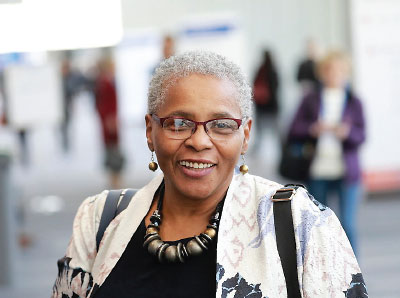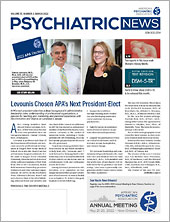The experience of mental illness is influenced by a patient’s cultural background, and the risk of mental illness is significantly associated with social determinants of health and mental health.
These include racism and structures in society that perpetuate racial discrimination and that influence the risk of early adverse experiences and trauma across all social strata.
Those insights have informed a rigorous examination of terminology and content throughout DSM-5-TR—including research reporting prevalence and risk factors in specific ethnic communities—by content leaders involved in updating the text of the manual, issued by APA Publishing this month.
For the first time in the history of DSM, the work of two groups—the Ethnoracial Equity and Inclusion Work Group, co-chaired by Roberto Lewis-Fernández, M.D., and Danielle Hairston, M.D., and the Cross-Cutting Culture Review Group, also chaired by Lewis-Fernández—provide a comprehensive review and update of the impact of culture, race, and racism on diagnosis.
“Over the years, APA members and others in the mental health community have raised concerns about how race, racism, and ethno-racial differences have been handled within DSM,” said past APA President Altha Stewart, M.D., a member of the Ethnoracial Equity and Inclusion Work Group. “We heard them, and we have taken them into consideration throughout the DSM-5-TR revision process.”
“This process mirrored the way we built DSM,” Stewart said. “We created a work group with experts in cultural psychiatry representing different professions across mental health. This work group laid a framework for change that considered both the complexity of the DSM structure as well as the literature used to inform and support the text.”
“We were highly committed to use of language that challenged the view that race and genetics are the same thing. We use terms such as ‘racialized’ and ‘ethnoracial’—instead of ‘racial’—to highlight that the construct of race is determined by cultural, social, legal, and political factors. We eliminated the use of terms such as ‘minorities’ to classify races of people since it relegates these races to inferior or lesser-than status. And with respect to the U.S. and the world, these races of people typically referred to as ‘minorities’ are increasingly becoming the larger proportion of the population.”
Stewart said the work group looked especially closely at research literature used to support DSM diagnoses to ensure that when higher rates of disorders are attributed to specific communities, the studies had adequate sample sizes and account for social determinants of health and mental health—including racial bias and discrimination. “We offered disclaimers and clarifications whenever needed to provide the reader with background information such as when higher prevalence rates of disorders are reported in the Black or Indigenous communities.”
An example of a revision made by the work group was reconsideration of prevalence data related to substance use disorders among Native American communities.
Lewis-Fernández said language referencing higher rates of alcohol use disorder in adults was based on studies with small samples unrepresentative of the variations across tribal nations (some tribal nations have rates of substance use that are quite low). Also, the studies and resulting language did not reflect the social determinants of health and mental health—including a history of collective trauma—that may impact rates of substance use disorders.
Similarly, prevalence reports showing disproportionately high rates of schizophrenia in Black people were reconsidered in light of racial bias that may have influenced those rates. “Being aware of the many social and cultural factors that influence the process of assessment should help clinicians evaluate data and make a valid diagnosis,” said Lewis-Fernández.
The work group was formed in 2020, following the killing of George Floyd by a Minneapolis police officer. But Constance Dunlap, M.D., remarked that there has been a long history of Black psychiatrists—Chester Pierce, M.D., Carl Bell, M.D., Alvin Poussaint, M.D., Ezra Griffith, M.D., and William Lawson, M.D., among others—who called attention to the effects of race and racial discrimination on diagnosis.
Dunlap told Psychiatric News that when she was invited to join the work group, she expressed a concern that the group was being asked to “sanction” the manual. But she described a rigorous process in which the work group met twice a week for months going “line by line” through the manual, scrutinizing every passage for where ethnoracial differences might be relevant and adding relevant guidance.
“I gained an even greater respect for DSM through this process,” she said. “One of the reasons Blacks are misdiagnosed with schizophrenia is because people don’t follow the manual but let their biases and projections influence diagnosis. But if you follow the manual, you come to a proper diagnosis—because it’s a good manual.”
Dunlap said the work group especially kept in mind psychiatry residents and fellows who would be introduced to diagnosis through the manual. “This might be the first place our trainees are exposed to the effects of race on mental health and on diagnosis,” she said. “Understanding people and rendering a proper diagnosis means understanding their whole experience including their resilience and coping mechanisms.”
Dolores Malaspina, M.D., a member of the DSM Steering Committee and the Ethnoracial Equity and Inclusion Work Group, agreed. “As members of the Steering Committee, we closely read every section of the manual. I came to see that there were large movements in medicine that were not being well reflected—especially the recognition that social status over and over again predicts medical and psychiatric health, from mortality to cardiovascular health to depression and psychosis.”
She added that across all social strata, early life adversity and trauma more than triple the risk for psychiatric disorders. She remarked that when teaching residents, she asks how often they inquire about family history when evaluating a patient with psychosis. “Every hand goes up. But when I ask how often they inquire about early trauma—no hands. Yet trauma is enormously predictive of psychosis.
“We aren’t training people to appreciate these early determinants of psychiatric health,” Malaspina said. “As clinicians we need to better understand the lived experience of our patients.”
The Ethnoracial Equity and Inclusion Work Group complemented the work of the larger 28-member Cross-Cutting Culture Review Group, which included some of the same members. The Cross-Cutting Culture Review Group reviewed and updated all Section II disorder chapters for text related to culture or specific cultural communities, as well as the proposed diagnoses in Section III, “Conditions for Further Study.” Revisions are included in relevant text sections of each disorder, especially under the heading “Culture-Related Diagnostic Issues.”
Lewis-Fernández said every chapter was reviewed by a member of the committee for language, prevalence data, and other content relevant to culture. A subgroup of revisers recommended revisions where necessary, which were then reviewed for approval by the Steering Committee.
The Cross-Cutting Culture Review Group also updated the Section III chapter “Culture and Psychiatric Diagnosis,” which provides basic tools and information on integrating culture and social context in clinical assessment and diagnoses, with sections on key terms, cultural formulation, and cultural concepts of distress.
“Culture can affect the prevalence of psychiatric disorders, with some syndromes particularly prevalent in specific cultural contexts,” said DSM Steering Committee Chair Paul Appelbaum, M.D., who also was on the Ethnoracial Equity and Inclusion Work Group. “It can also impact the manifestations of a syndrome, such as major depression, which can vary across cultural groups. Recognition of the importance of these cultural factors is critical for accurate diagnosis of psychiatric disorders.” ■


